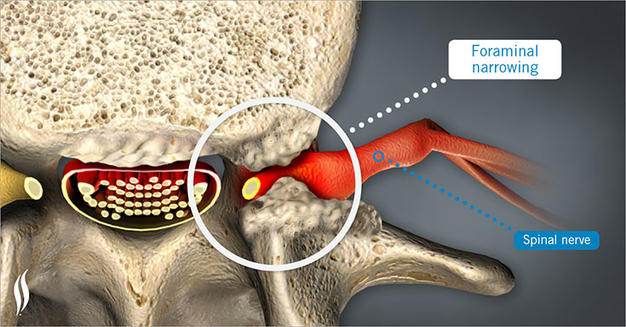
You may be a candidate for Endoscopic Foramintotomy
Foraminal Stenosis
The spine supports much of the upper body’s weight while protecting the spinal cord and facilitating movement. To accomplish these tasks, a complex system of stacked vertebrae, cartilage, joints, ligaments, and muscles work in tandem, with each component depending upon another to function properly. Because the spine absorbs a great deal of the stress and strain of everyday life, it is prone to degeneration over time. When one part of the spine begins to deteriorate, it can quickly affect nearby regions and cause debilitating and/or painful symptoms.
The foraminal passageways, through which important nerves branch away from the spinal cord and travel to other areas of the body, are particularly susceptible to damage and decline. “Foraminal stenosis” occurs when these canals become obstructed or narrowed. Usually, foraminal stenosis becomes noticeable when a nerve becomes compressed, leading to pain, discomfort, and other complications. Although foraminal narrowing can become a serious condition, it is generally treatable with prompt medical attention and proper care.
Causes
The age-related decline of the vertebral column is the primary cause of foraminal stenosis. However, many factors can exacerbate or accelerate the narrowing of the foraminal canals, including:
- Bone spurs
- Herniated or bulging discs
- Arthritis
- Ligament thickening
- Facet joint swelling
- Sudden injuries from falls, high-impact sports, or motor vehicle accidents
- Repetitive, strenuous movements or improper lifting
- Excess weight or obesity
- Smoking
- Lack of exercise
- Family history or genetic predisposition
If you believe you may be at risk for developing foraminal stenosis or other spine disorders, schedule a consultation with Dr. T to discuss preventative measures. By making minor lifestyle changes and proactively treating issues as they arise, it is possible to manage, delay, or even alleviate spine degeneration.
Symptoms
Symptoms of foraminal stenosis vary depending on the affected spinal region (cervical, thoracic, or lumbar) and severity. Common symptoms include:
- Pain and discomfort that may radiate to nearby extremities
- Muscle weakness
- Numbness
- Tingling or “pins-and-needles” sensations
- Unexplained symptoms in the neck, shoulders, arms, hands, lower back, hips, buttocks, legs, or feet
- Sciatica
- Difficulty participating in everyday activities without discomfort
Because foraminal stenosis symptoms overlap with other conditions, it is essential to seek a comprehensive and accurate diagnosis. Dr. T is committed to identifying the underlying cause of your symptoms.
Our Microspine & Minimally Invasive Approach
If you are experiencing foraminal stenosis, you are not alone. You do not have to accept your pain as a permanent part of your life. Through personalized, patient-centric care, Dr. T at Microspine ensures that each patient regains their quality of life, free of symptoms.
Dr. T will carefully evaluate your medical history, symptoms, and physical state to develop a customized treatment plan. We recommend exploring conservative treatment options before considering surgery. Non-invasive methods that may reduce symptoms include:
- Physical Therapy and Moderate Exercise: Targeted physical therapy and activity can reduce strain on the spine. Weight loss, flexibility exercises, and core strengthening can help alleviate foraminal stenosis symptoms. Professional massage may also provide therapeutic benefits.
- Medication: Over-the-counter and prescription medications can reduce inflammation and pain. Localized pain-relieving injections may offer relief for up to six months.
- Lifestyle Modifications: Maintaining good posture, using orthopedic footwear, avoiding triggering activities, and making small adjustments can significantly relieve symptoms.
If non-surgical treatments do not provide sufficient relief, Microspine Endoscopic Decompression may be recommended. This minimally invasive, outpatient procedure is performed under general or twilight anesthesia. Compared to traditional open surgery, Microspine minimally invasive procedures offer benefits such as:
- Shorter recovery times
- Reduced risk of scarring and blood loss
- Minimal trauma to surrounding muscles and tissues
- Less post-operative pain
Because of these advantages, Microspine Endoscopic Spine Surgery is considered the most advanced treatment for foraminal stenosis. During the procedure, Dr. T may remove bone spurs and obstructions while repairing intervertebral discs using small incisions.
We look forward to helping you feel better, faster! CONTACT US
